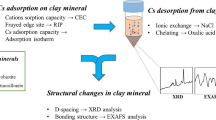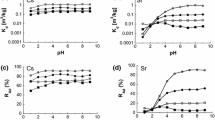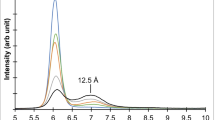Abstract
Cesium (Cs+) is known to have a strong interaction with various clay minerals; however, it is not interpreted from the structure of clay minerals and the adsorption isotherm. The adsorption interactions between Cs+ and hydrobiotite (H-Bio), biotite (Bio), vermiculite (Verm), and exfoliated vermiculite (E-Verm) were evaluated by analyzing adsorption isotherm, basal spacing, and adsorption/desorption experiments. The Cs+ adsorption of H-Bio and Verm fitted well to the Langmuir adsorption isotherm, while the Cs+ adsorption of Bio and E-Verm fitted well to the Freundlich adsorption isotherm. The basal spacing of H-Bio and Verm was approximately 1.4 nm, while Bio and E-Verm basal spacing was 1.0 nm. The adsorption experiment results for Cs+ under the coexistence of Ca2+ and K+ indicated that the contribution of the interlayer sites to Cs+ adsorption on H-Bio and Verm was 25–40%, while the contribution of the interlayer sites to that on Bio and E-Verm was almost 0%. The adsorption isotherms reflected this interlayer contribution to Cs+ adsorption, which was dependent on the basal spacing. Therefore, the basal spacing of clay minerals is one of the key structural properties controlling both the adsorption capacity and the adsorption mechanism of Cs+ in clay minerals.







Similar content being viewed by others
Data availability
The datasets used and/or analyzed during the current study are available from the corresponding author on reasonable request.
References
Chino M, Nakayama H, Nagai H, Terada H, Katata G, Yamazawa H (2011) Preliminary estimation of release amounts of 131I and 137Cs accidentally discharged from the Fukushima Daiichi Nuclear Power Plant into the atmosphere. J Nucl Sci Technol 48:1129–1134. https://doi.org/10.1080/18811248.2011.9711799
Cremers A, Elsen A, De Preter P, Maes A (1988) Quantitative analysis of radiocaesium retention in soils. Nature 335:247–249. https://doi.org/10.1038/335247a0
Delvaux B, Kruyts N, Cremers A (2000) Rhizospheric mobilization of radiocesium in soils. Environ Sci Technol 34:1489–1493. https://doi.org/10.1021/es990658g
Dzene L, Tertre E, Hubert F, Ferrage E (2015) Nature of the sites involved in the process of cesium desorption from vermiculite. J Colloid Interface Sci 455:254–260. https://doi.org/10.1016/j.jcis.2015.05.053
Fan Q, Yamaguchi N, Tanaka M, Tsukada H, Takahashi Y (2014a) Relationship between the adsorption species of cesium and radiocesium interception potential in soils and minerals: an EXAFS study. J Environ Radioact 138:92–100. https://doi.org/10.1016/j.jenvrad.2014.08.009
Fan QH, Tanaka M, Tanaka K, Sakaguchi A, Takahashi H (2014b) An EXAFS study on the effects of natural organic matter and the expandability of clay minerals on cesium adsorption and mobility. Geochim Cosmochim Acta 135:49–65. https://doi.org/10.1016/j.gca.2014.02.049
Gruner JW (1934) The structure of vermiculite and their collapse by dehidration. Am Mineral 19:557–575
Gunter ME (2005) Differentiation of commercial vermiculite based on statistical analysis of bulk chemical data: fingerprinting vermiculite from Libby, Montana U.S.A. Am Mineral 90:749–754. https://doi.org/10.2138/am.2005.1789
Hashimoto S, Ugawa S, Nanko K, Shichi K (2012) The total amounts of radioactively contaminated materials in forests in Fukushima, Japan. Sci Rep 1–5. https://doi.org/10.1038/srep00416
Ho Y-S (2004) Selection of optimum sorption isotherm. Carbon 42:2115–2116. https://doi.org/10.1016/j.carbon.2004.03.019
Kato H, Onda Y, Teramage M (2012) Depth distribution of 137Cs, 134Cs, and 131I in soil profile after Fukushima Dai-ichi Nuclear Power Plant Accident. J Environ Radioact 111:59–64. https://doi.org/10.1016/j.jenvrad.2011.10.003
Kikuchi R, Kogure T (2018) Structural and compositional variances in “hydrobiotite” sample from Palabora, South Africa. Clay Sci 22:39–52. https://doi.org/10.11362/jcssjclayscience.22.2
Kikuchi R, Mukai H, Kuramata C, Kogure T (2015) Cs–sorption in weathered biotite from Fukushima granitic soil. J Mineral Petrol Sci 110:126–134. https://doi.org/10.2465/jmps.141218
Koarashi J, Atarashi-Andoh M, Matsunaga T, Sato T, Nagao S, Nagai H (2012) Factors affecting vertical distribution of Fukushima accident-derived radiocesium in soil under different land-use conditions. Sci Total Environ 431:392–401. https://doi.org/10.1016/j.scitotenv.2012.05.041
Kogure T, Morimoto K, Tamura K, Sato H, Yamagishi A (2012) XRD and HRTEM evidence for fixation of cesium ions in vermiculite clay. Chem Lett 41:380–382. https://doi.org/10.1246/cl.2012.380
Kogure T, Murakami T (1996) Direct identification of biotite/vermiculite layers in hydrobiotite using high-resolution TEM. Mineral J 18:131–137
Lee J, Park S-M, Jeon E-K, Baek K (2017) Selective and irreversible adsorption mechanism of cesium on illite. Appl Geochem 85:188–193. https://doi.org/10.1016/j.apgeochem.2017.05.019
Lepage H, Evrard O, Onda Y, Lefèvre I, Laceby JP, Ayrault S (2015) Depth distribution of cesium-137 in paddy fields across the Fukushima pollution plume in 2013. J Environ Radioact 147:157–164. https://doi.org/10.1016/j.jenvrad.2015.05.003
Long H, Wu P, Yang L, Huang Z, Zhu N, Hu Z (2014) Efficient removal of cesium from aqueous solution with vermiculite of enhanced adsorption property through surface modification by ethylamine. J Colloid Interface Sci 428:295–301. https://doi.org/10.1016/j.jcis.2014.05.001
Malins A, Kurikami H, Nakama S, Saito T, Okumura M, Machid M, Kitamura A (2016) Evaluation of ambient dose equivalent rates influenced by vertical and horizontal distribution of radioactive cesium in soil in Fukushima Prefecture. J Environ Radioact 151:38–49. https://doi.org/10.1016/j.jenvrad.2015.09.014
McKinley JP, Zeissler CJ, Zachara JM, Serne RJ, Lindstrom RM, Schaef HT, Orr RD (2001) Distribution and retention of 137Cs in sediments at the Hanford Site, Washington. Environ Sci Technol 35:3433–3441. https://doi.org/10.1021/es0018116
Motokawa R, Endo H, Yokoyama S, Ogawa H, Kobayashi T, Suzuki S, Yaita T (2014) Mesoscopic structures of vermiculite and weathered biotite clays in suspension with and without cesium ions. Langmuir 30:15127–15134. https://doi.org/10.1021/la503992p
Mukai H, Hatta T, Kitazawa H, Yamada H, Yaita T, Kogure T (2014) Speciation of radioactive soil particles in the Fukushima contaminated area by IP autoradiography and microanalyses. Environ Sci Technol 48:13053–13059. https://doi.org/10.1021/es502849e
Mukai H, Hirose A, Motai S, Kikuchi R, Tanoi K, Nakanichi TM, Yaita T, Kogure T (2016a) Cesium adsorption/desorption behavior of clay minerals considering actual contamination conditions in Fukushima. Sci Rep 6:21543. https://doi.org/10.1038/srep21543
Mukai H, Motai S, Yaita T, Kogure T (2016b) Identification of the actual cesium-adsorbing materials in the contaminated Fukushima soil. Appl Clay Sci 121–122:188–193. https://doi.org/10.1016/j.clay.2015.12.030
Nakao A, Ogasawara S, Sano O, Ito T, Yanai J (2014) Radiocesium sorption in relation to clay mineralogy of paddy soils in Fukushima, Japan. Sci Total Environ 468–469:523–529. https://doi.org/10.1016/j.scitotenv.2013.08.062
Nakao A, Thiry Y, Funakawa S, Kosaki T (2008) Characterization of the frayed edge site of micaceous minerals in soil clays influenced by different pedogenetic conditions in Japan and northern Thailand. Soil Sci Plant Nutr 54:479–489. https://doi.org/10.1111/j.1747-0765.2008.00262.x
Okumura M, Kerisit S, Bourg IC, Lammers LN, Ikeda T, Sassi M, Rosso KM, Machid M (2018) Radiocesium interaction with clay minerals: theory and simulation advances Post–Fukushima. J Environ Radioact 189:135–145. https://doi.org/10.1016/j.jenvrad.2018.03.011
Park S-M, Yang J-S, Tsang DCW, Alessi DS, Baek K (2019) Enhanced irreversible fixation of cesium by wetting and drying cycles in soil. Environ Geochem Health 41:149–157. https://doi.org/10.1007/s10653-018-0174-0
Sano O, Ito T, Ando T, Nanzyo M, Saito G, Saigusa M (2010) Clay mineralogical composition of representative paddy soils in southern part of northeastern Japan. Pedologist 54:83–92 (In Japanese)
Sato T (2011) Background and problematics of radioactive contamination by the accident at Fukushima Dai-ichi nuclear power plant. Nendo Kagaku 50:26–32 (In Japanese). https://doi.org/10.11362/jcssjnendokagaku.50.2_26
Sawhney BL (1972) Selective sorption and fixation of cations by clay minerals: a review. Clay Clay Miner 20:93–100. https://doi.org/10.1346/CCMN.1972.0200208
Shirozu H (1988) Introducation to clay mineralogy –fundamentals for clay science. Asakurashoten, Tokyo (In Japanese)
Suzuki N, Ozawa S, Ochi K, Chikuma T, Watanabe Y (2013) Approaches for cesium uptake by vermiculite. J Chem Technol Biotechnol 88:1603–1605. https://doi.org/10.1002/jctb.4145
Takeda A, Tsukada H, Yamaguchi N, Takeuchi M, Sato M, Nakao A, Hisamatsu S (2014) Relationship between the radiocesium interception potential and the transfer of radiocesium from soil to soybean cultivated in 2011 in Fukushima Prefecture, Japan. J Environ Radioact 137:119–124. https://doi.org/10.1016/j.jenvrad.2014.06.022
Tanaka K, Takahashi Y, Sakaguchi A, Umeo M, Hayakawa S, Tanida H, Saito T, Kanai Y (2012) Vertical profiles of iodine-131 and cesium-137 in soils in Fukushima prefecture related to the Fukushima Daiichi Nuclear Power Station accident. Geochem J 46:73–76. https://doi.org/10.2343/geochemj.1.0137
Toriyama J, Kobayashi M, Hiruta T, Shichi K (2018) Distribution of radiocesium in different density fractions of temperate forest soils in Fukushima. For Ecol Manag 409:260–266. https://doi.org/10.1016/j.foreco.2017.11.024
Wauters J, Elsen A, Cremers A, Konoplev AV, Bulgakov AA (1996) Prediction of solid/liquid distribution coefficients of radiocaesium in soils and sediments. Part one: a simplified procedure for the solid phase characterisation. Appl Geochem 11:589–594. https://doi.org/10.1016/0883-2927(96)00027-3
Acknowledgments
The analysis of biotite and vermiculite were performed by using an XRF at the “Joint-use Facilities: Laboratory of Nano-Micro Material Analysis,” and XRD at the “The High Brilliance X-Ray Laboratory,” Hokkaido University, supported by “Material Analysis and Structure Analysis Open Unit (MASAOU).” We would like to thank Editage (www.editage.com) for English language editing.
Author information
Authors and Affiliations
Contributions
Yasuhiro Akemoto: Conceptualization, methodology, formal analysis and investigation, writing—original draft preparation.
Satya Candra Wibawa Sakti: Methodology, formal analysis and investigation, writing—review and editing.
Masahiko Kan: Writing—review and editing.
Shunitz Tanaka: Writing—review and editing, supervision.
Corresponding authors
Ethics declarations
Ethical approval and consent to participate
Not applicable.
Consent for publication
Not applicable.
Competing interests
The authors declare that they have no competing interests.
Additional information
Responsible Editor: Kitae Baek
Publisher’s note
Springer Nature remains neutral with regard to jurisdictional claims in published maps and institutional affiliations.
Supplementary Information
ESM 1
(DOCX 15 kb)
Rights and permissions
About this article
Cite this article
Akemoto, Y., Sakti, S.C.W., Kan, M. et al. Interpretation of the interaction between cesium ion and some clay minerals based on their structural features. Environ Sci Pollut Res 28, 14121–14130 (2021). https://doi.org/10.1007/s11356-020-11476-7
Received:
Accepted:
Published:
Issue Date:
DOI: https://doi.org/10.1007/s11356-020-11476-7




